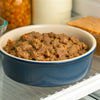Can Mixing Wet and Dry Dog Food Cause Diarrhea? Treatment Tips and Insights
- Houndsy
Table of Contents
- Introduction
- The Importance of a Balanced Diet for Dogs
- Can Mixing Wet and Dry Dog Food Cause Diarrhea?
- Treatment for Diarrhea Triggered by Food Mixing
- Best Practices When Mixing Wet and Dry Dog Food
- Conclusion
Introduction
As devoted dog parents, we all want our furry companions to thrive. The quality of our dog's diet is fundamental to their health and well-being. Yet, the question of whether mixing wet and dry dog food can lead to digestive issues like diarrhea often surfaces among dog owners. In fact, recent surveys indicate that nearly 40% of pet owners have experienced some level of gastrointestinal upset in their pets due to dietary changes.
Understanding the implications of mixing food types is essential in crafting a nutritious and safe diet for our dogs. By exploring the reasons behind potential digestive disturbances, we can better navigate our pets' nutritional needs.
In this blog post, we aim to comprehensively analyze the effects of mixing wet and dry dog food, potential reasons for diarrhea, treatment options, and practical strategies for ensuring your dog's diet is both satisfying and safe. By gaining this knowledge, we can foster better feeding practices that promote our pets' health and happiness.
The Importance of a Balanced Diet for Dogs
When it comes to feeding our dogs, providing a balanced and nutrient-dense diet is crucial. Dogs require specific nutrients to maintain their energy levels, support their immune systems, and promote their overall growth and well-being. The two main types of dog food we often consider are dry (kibble) and wet food.
The Benefits of Dry Dog Food
- Convenience: Dry dog food is easy to store and measure.
- Dental Health: The gritty texture of kibble can help reduce tartar buildup on your dog’s teeth.
- Cost-Effective: Generally less expensive than wet food over time.
The Benefits of Wet Dog Food
- Hydration: Wet food contains more moisture, helping keep dogs hydrated.
- Palatability: Many dogs find wet food tastier, making it appealing for picky eaters.
- Easier Digestion: Wet food can be easier for older dogs or those with dental issues to eat and digest.
A Summary of Nutritional Needs
Whichever type of food you choose, it's important that it meets AAFCO (Association of American Feed Control Officials) standards for complete and balanced nutrition. Essential nutrients include:
- Proteins: For muscle maintenance and repair.
- Fats: For energy and healthy skin and coat.
- Carbohydrates: For energy and digestive health.
- Vitamins and Minerals: For overall bodily function and metabolism.
Balancing these elements is key to ensuring our pets receive a wholesome diet that aids in their growth, health, and happiness.
Can Mixing Wet and Dry Dog Food Cause Diarrhea?
The short answer is: yes, mixing wet and dry dog food can potentially lead to digestive issues, including diarrhea, especially if not done correctly. Let's explore the reasons behind this phenomenon.
1. Sudden Dietary Changes
When we introduce a new food type into our dog's diet—whether it's wet food or a mixed diet—it creates changes that their digestive systems need to adapt to. Rapid changes can disrupt their gut health and thereby trigger diarrhea.
Example: Transition Slowly
Similar to humans, gradual transitions allow a dog's digestive flora to adjust to new food types, reducing the likelihood of upset stomachs. For instance, if you plan to mix wet and dry dog food, start with a small combination and gradually increase the proportion over several days.
2. Differences in Ingredients
Wet and dry dog foods often contain different proteins, carbohydrates, and fillers, which may not combine well in a sensitive digestive system. Mixing them can overwhelm a dog that is not used to specific ingredients or textures.
Nutritional Sensitivities
Some dogs may have sensitivities to specific ingredients, prevalent in either wet or dry foods. Identifying these ingredients can help prevent diarrhea caused by food intolerances.
3. Bacterial Overgrowth
Both wet and dry foods require proper handling and storage. Leaving mixed food out for extended periods may encourage bacterial overgrowth, resulting in diarrhea or gastrointestinal disturbances.
Pro Tip:
To mitigate this risk, always ensure mixed food is consumed within 20-30 minutes, especially if feeding your dog outdoors in warmer weather.
Treatment for Diarrhea Triggered by Food Mixing
If your dog experiences diarrhea after mixing wet and dry food, it's important to approach the situation with care. Our aim should be to understand the underlying issue and provide thoughtful treatment options.
1. Withhold Food Temporarily
Initially, withholding food for about 12 hours can give your dog’s digestive system a chance to recover. However, ensure your dog has access to fresh water to stay hydrated.
2. Gradual Reintroduction of Food
After a brief fasting period, introduce a bland diet (with boiled chicken and rice) in small amounts. Once stools return to normal, gradually reintroduce their regular diet, being watchful of any signs of discomfort or recurrence of diarrhea.
3. Monitor Hydration
Dogs with diarrhea run the risk of dehydration. To prevent this, ensure they have constant access to clean, fresh water. In some cases, offering an electrolyte solution made for pets can help.
4. Consult with Your Veterinarian
If you notice prolonged diarrhea (lasting more than a day or two), consult your veterinarian for further assessment. Diarrhea can be a sign of more serious underlying health issues, such as parasites or infections.
Best Practices When Mixing Wet and Dry Dog Food
To effectively mix wet and dry food without causing digestive distress in your dog, consider the following strategies:
1. Slow Introduction Method
Transition to a mixed diet gradually; slowly add wet food over a week. A good starting point might be:
- Day 1-3: 75% dry food, 25% wet food
- Day 4-6: 50% dry food, 50% wet food
- Day 7 onward: Adjust to your dog's preference, aiming for a balanced mix.
2. Keep Foods Separate Initially
Consider keeping wet and dry foods separate during initial feeding times to monitor your dog’s reaction to each. If one type seems to cause digestive upset, you can identify the culprit more easily.
3. Focus on Quality Ingredients
Choose high-quality dog foods free from artificial additives or fillers that might upset your dog’s stomach. The quality of the food can significantly influence your dog's digestion.
4. Understand Your Dog’s Individual Needs
Every dog is unique, with specific dietary requirements based on breed, age, and health conditions. Tailor their diet to suit their nutritional needs and avoid common allergens.
Conclusion
Mixing wet and dry dog food can be a great way to enhance your dog's meals—encouraging hydration and improving palatability. However, there are potential downsides that dog parents should remain aware of, particularly surrounding gastrointestinal health. By considering factors such as gradual introductions, ingredient sensitivities, and proper food storage techniques, we can mitigate risks and promote healthier feeding routines.
If you're looking to elevate your dog's feeding experience and enhance convenience, consider the Houndsy Kibble Dispenser. With its stylish design and ergonomic functionality, it makes feeding time enjoyable and efficient for both you and your dog.
Are there other strategies or experiences you’ve had mixing wet and dry dog food? We’d love to hear your insights!
FAQ
Q: Can mixing wet and dry dog food cause diarrhea?
A: Yes, sudden dietary changes and ingredient sensitivities can potentially lead to diarrhea in dogs.
Q: How can I transition my dog to a mixed diet?
A: Introduce the new food gradually over a period of several days, starting with small proportions.
Q: What should I do if my dog has diarrhea?
A: Withhold food temporarily, ensure hydration, and consult your veterinarian if the symptoms persist.
Q: Are there any risks associated with leaving mixed food out?
A: Yes, leaving combined food out for too long can promote bacterial growth and result in gastrointestinal upset.
Q: Should I always seek veterinary advice for dietary changes?
A: It's a good practice to consult your veterinarian, especially if your dog has pre-existing health conditions or dietary restrictions.












